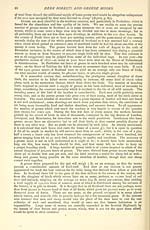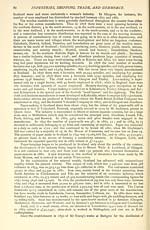Ordnance gazetteer of Scotland > Volume 6
(409) Page 81
Download files
Complete book:
Individual page:
Thumbnail gallery: Grid view | List view

INDUSTRIES, SHIPPING, TRADE, AND COMMERCE.
81
XI. INDUSTRIES, SHIPPING, TRADE, AND COMMERCE.
By H. A. Webster, of the Encyclopedia Britannica.
INDUSTRY.
The linen manufacture is of great antiquity in Scotland, and by the close of the 16th
century linen goods formed the principal article of export to foreign countries. But the flax
continued to be spun upon the hand-wheel down to the last years of the 18th century, and in
many districts well on into the present century. People now living are still using napery and
sheeting every thread of which was spun by their grandmothers, or even their mothers, and their
maidens, to whom the whirr of the wheel was as familiar as the sound of their own fireside
gossip. In 1822 the quantity of linen stamped in Scotland was 36,268,530 yards, valued at
;£i, 396,295. By 1837 the flax factories employed 15,462 hands, and by 1856, 31,722. In the
latter year there were 168 factories, with 278,304 spindles and 401 1 power-looms driven by
6346 horse-power, of which 5529 was steam. In 1878 (the latest year for which general
statistics have been published by Her Majesty's inspectors) the number of factories was 155, with
265,263 spinning spindles, 18,495 doubling spindles, and 16,756 power-looms; and the number
of hands employed was 9987 males and 27,489 females. Of the factories 67 were for spinning
only (194,299 spinning spindles, 16,368 doubling spindles; 4568 male and 9758 female
employees), 70 for weaving only (13,233 power-looms ; 2726 male and 10,547 female employees),
and 14 for both weaving and spinning (70,964 spinning spindles, 2127 doubling spindles, and
3523 power-looms; 2314 male and 7054 female employees). The district in which the flax
manufacture is most extensively carried on is the east midland, including Forfar, Perth, Kinross,
and Clackmannan. Dundee (q.v.) and Dunfermline are the great centres of the industry, the
former for the coarser fabrics such as sailcloth (for the British Royal Navy and that of the United
States), sacking, and sheeting; the latter for table linen, in the production of which it hardly
has a rival in the world. Kirkcaldy, Arbroath, Forfar, Kirriemuir, Blairgowrie, Montrose, and
Aberdeen are also largely engaged in different departments of this manufacture. Paisley is
the great seat of the sewing thread manufacture. Hemp forms the material of a closely
associated industry, to which, however, only three factories are devoted in the east midland
district (3630 spinning spindles in 1878, 988 doubling spindles; 176 males and 289 female
employees). 'There can be no question,' according to Mr Henderson's report in 1883, that
' the flax spinning trade has been harder hit by foreign competition than any other branch of
our textile industries. The importations of flax yarns from the Continent, particularly from
Belgium, have increased enormously of late years, and the market for flax goods is being con-
stantly encroached upon by the manufacturers of jute and cotton. The rise of the jute industry
has been remarkably rapid : this silky fibre of the Corchorns, scarcely known in the country
about 1835, has since that year, and especially since r86o, gradually become in place of flax
the great staple on which the prosperity of Dundee depends. The single factory of the Messrs
Cox in Dundee turns out jute fabrics to the extent of nearly 16,000 miles per annum. Jute is
also manufactured at Aberdeen. See Alexander J. Warden, The Linen Trade, Ancient and
Modern (London, 1864).
In several towns where the linen was once of importance, such as Glasgow and Paisley,
the cotton manufacture has taken its place. The first steam-engine for a cotton factory in
Scotland was built in 1792. By 1837 the number of cotton mills in the country 'was 177,
nearly all those of considerable size being situated in Glasgow or within a radius of 20 or 30
miles' from that city, where the raw material was mainly imported. In 1857 the cotton factories
numbered 152, with 2,041,129 spindles and 21,624 power-looms, driven by 9971 horse-power
(7641 steam), employing 7609 males and 27,089 females. The following are the figures for
the cotton factories in 1S78 : —
Factories.
Spinning
Spindles.
Double
Spindles.
Power- looms.
Males. Females, i „ To , tal .
Employed.
Spinning only,
Weaving only,
Spinning and weaving,
Others, ....
37
30
14
8
587,699
373.560
512,974
13.620
13,649
8,616
2,338 | 11,172
961 6,942
1,103 7,021
82 156
13.510 j
7,903
8,124 1
238 1
Total, . . . .89 961,259
526,594
22,265 1 4,484
25,291 ! 29,775
Of the 37 spinning factories 32 were in the south-western district. Cotton spinning has con-
siderably declined of late years, especially in Glasgow and its vicinity ; but the weaving branch
of the trade still retains a firm hold on the district. The industry as a whole is becoming in
L
81
XI. INDUSTRIES, SHIPPING, TRADE, AND COMMERCE.
By H. A. Webster, of the Encyclopedia Britannica.
INDUSTRY.
The linen manufacture is of great antiquity in Scotland, and by the close of the 16th
century linen goods formed the principal article of export to foreign countries. But the flax
continued to be spun upon the hand-wheel down to the last years of the 18th century, and in
many districts well on into the present century. People now living are still using napery and
sheeting every thread of which was spun by their grandmothers, or even their mothers, and their
maidens, to whom the whirr of the wheel was as familiar as the sound of their own fireside
gossip. In 1822 the quantity of linen stamped in Scotland was 36,268,530 yards, valued at
;£i, 396,295. By 1837 the flax factories employed 15,462 hands, and by 1856, 31,722. In the
latter year there were 168 factories, with 278,304 spindles and 401 1 power-looms driven by
6346 horse-power, of which 5529 was steam. In 1878 (the latest year for which general
statistics have been published by Her Majesty's inspectors) the number of factories was 155, with
265,263 spinning spindles, 18,495 doubling spindles, and 16,756 power-looms; and the number
of hands employed was 9987 males and 27,489 females. Of the factories 67 were for spinning
only (194,299 spinning spindles, 16,368 doubling spindles; 4568 male and 9758 female
employees), 70 for weaving only (13,233 power-looms ; 2726 male and 10,547 female employees),
and 14 for both weaving and spinning (70,964 spinning spindles, 2127 doubling spindles, and
3523 power-looms; 2314 male and 7054 female employees). The district in which the flax
manufacture is most extensively carried on is the east midland, including Forfar, Perth, Kinross,
and Clackmannan. Dundee (q.v.) and Dunfermline are the great centres of the industry, the
former for the coarser fabrics such as sailcloth (for the British Royal Navy and that of the United
States), sacking, and sheeting; the latter for table linen, in the production of which it hardly
has a rival in the world. Kirkcaldy, Arbroath, Forfar, Kirriemuir, Blairgowrie, Montrose, and
Aberdeen are also largely engaged in different departments of this manufacture. Paisley is
the great seat of the sewing thread manufacture. Hemp forms the material of a closely
associated industry, to which, however, only three factories are devoted in the east midland
district (3630 spinning spindles in 1878, 988 doubling spindles; 176 males and 289 female
employees). 'There can be no question,' according to Mr Henderson's report in 1883, that
' the flax spinning trade has been harder hit by foreign competition than any other branch of
our textile industries. The importations of flax yarns from the Continent, particularly from
Belgium, have increased enormously of late years, and the market for flax goods is being con-
stantly encroached upon by the manufacturers of jute and cotton. The rise of the jute industry
has been remarkably rapid : this silky fibre of the Corchorns, scarcely known in the country
about 1835, has since that year, and especially since r86o, gradually become in place of flax
the great staple on which the prosperity of Dundee depends. The single factory of the Messrs
Cox in Dundee turns out jute fabrics to the extent of nearly 16,000 miles per annum. Jute is
also manufactured at Aberdeen. See Alexander J. Warden, The Linen Trade, Ancient and
Modern (London, 1864).
In several towns where the linen was once of importance, such as Glasgow and Paisley,
the cotton manufacture has taken its place. The first steam-engine for a cotton factory in
Scotland was built in 1792. By 1837 the number of cotton mills in the country 'was 177,
nearly all those of considerable size being situated in Glasgow or within a radius of 20 or 30
miles' from that city, where the raw material was mainly imported. In 1857 the cotton factories
numbered 152, with 2,041,129 spindles and 21,624 power-looms, driven by 9971 horse-power
(7641 steam), employing 7609 males and 27,089 females. The following are the figures for
the cotton factories in 1S78 : —
Factories.
Spinning
Spindles.
Double
Spindles.
Power- looms.
Males. Females, i „ To , tal .
Employed.
Spinning only,
Weaving only,
Spinning and weaving,
Others, ....
37
30
14
8
587,699
373.560
512,974
13.620
13,649
8,616
2,338 | 11,172
961 6,942
1,103 7,021
82 156
13.510 j
7,903
8,124 1
238 1
Total, . . . .89 961,259
526,594
22,265 1 4,484
25,291 ! 29,775
Of the 37 spinning factories 32 were in the south-western district. Cotton spinning has con-
siderably declined of late years, especially in Glasgow and its vicinity ; but the weaving branch
of the trade still retains a firm hold on the district. The industry as a whole is becoming in
L
Set display mode to: Large image | Transcription
Images and transcriptions on this page, including medium image downloads, may be used under the Creative Commons Attribution 4.0 International Licence unless otherwise stated. ![]()
| Gazetteers of Scotland, 1803-1901 > Ordnance gazetteer of Scotland > Volume 6 > (409) Page 81 |
|---|
| Permanent URL | https://digital.nls.uk/97392510 |
|---|
| Attribution and copyright: |
|
|---|---|

